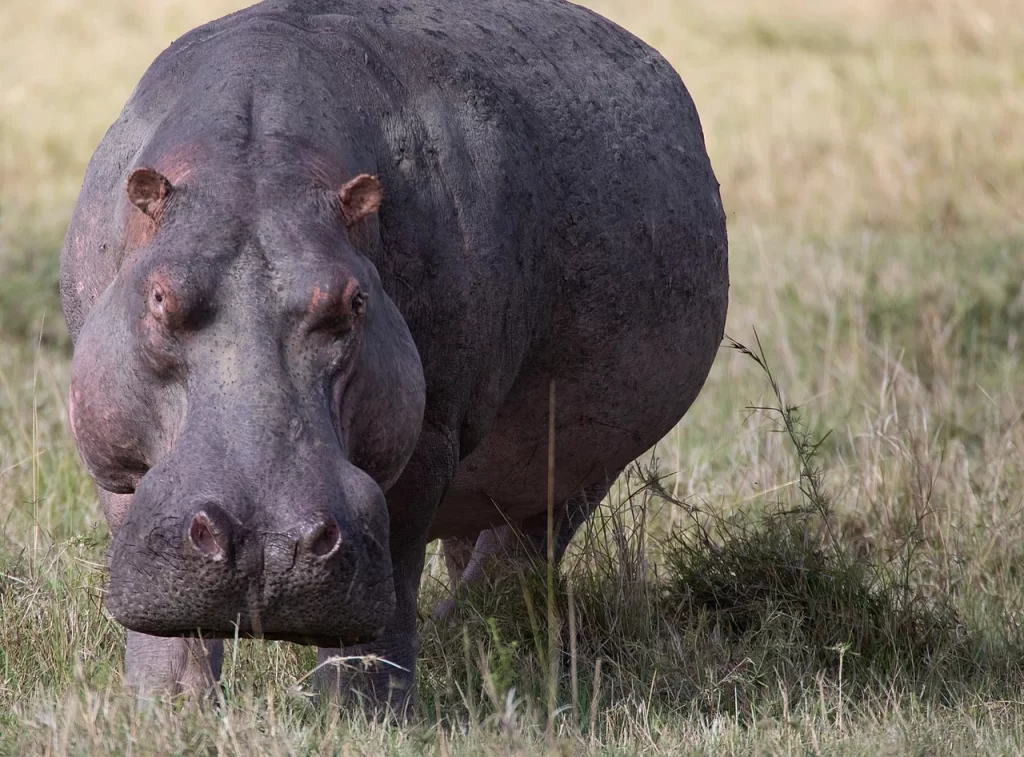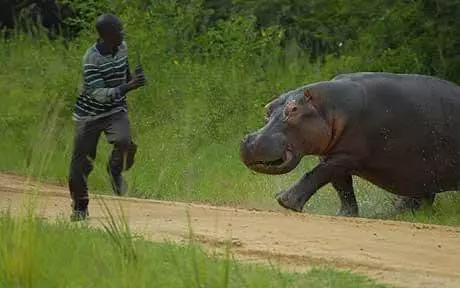Hippopotamus or (hippo for short) are the third largest land mammals on earth. According to the IUCN Red List, the herbivores which are found in sub-saharan Africa are classified as vulnerable and dangerous.
There are two species of hippopotamus; common hippopotamus (hippopotamus amphibious) and pygmy hippo (choeropsis liberiensis or hexaprotodon liberiensis). Hippos weigh between 30-50 pounds (14-23 kilograms) at birth and have a life expectancy of 50 years.
So, are there different species of hippos? What are the development milestones in a hippo’s life? How do they mark their territory? What about its mobility? How fast are they? Read on to find out all you need to know about this animal.

- A Hippo Can Open Its Mouth To Full 180 Degrees
The Guiness book of record recognizes the hippopotamus (Hippopotamus amphibius) for having the largest mouth of all land animals and the second largest in the animal kingdom (the blue whale leads the pack).
When closed a hippo’s mouth generally measures 2 feet wide (from left to right). The hippo can open its mouth to almost 180 degrees. Technically, this means the distance from the upper jaw and lower jaw is a flat line; this equates to an average of 4 ft (1.2 m), enough for a toddler to stand up in.

The impressive wide gap is because hippos have their jaw hinge extremely far back in their heads thus enabling their special muscles (the orbicularis oris muscle) to easily unfold when they stretch their mouths to a near perfect rotation. Normally, hippos are herbivores so the ability to stretch is exclusively used as a show of might to intimidate other hippos and animals alike. They also open their mouth wide as they yawn.
- A Hippos Teeth Keep Growing With Age
Hippos have the longest and largest teeth of any land animal; a complete set of heterodont teeth: a canine, incisors, molars and premolars. The male hippos have longer teeth than the female hippos. On average, the large semi-aquatic mammal has 36 teeth in each quadrant. Their dental formula consists of: 1/1 canines, 2/2 incisors, premolars 3-4/3-4 and molars 3/3. Some may have slightly more because of the milk teeth which are retained after reaching adulthood.
The canines, the front teeth located on the outside edges of their mouths, can reach up to 28 inches in length. Their incisors, the two front teeth on the top and bottom, can reach up to 15 inches in length. The teeth grow continuously and self sharpen when the animal’s mouth is shut.
The tusks (incisor and canine teeth) are used for self-defense, mainly to defend their territory against other hippos. The molars and premolars which aren’t imposing as other teeth are designed for chewing plant material. The molars allow them to process large amounts of plant material, hippos can devour up to 35kg of their favorite grub.
- Hippos Can Run Really Fast Despite Their Massive Size

Hippos are the second largest land animals on earth. On average, a hippo’s length ranges between 10.8 and 16.5 feet, and their height is up to 5.2 feet tall at the shoulder. Male hippos weigh between 3,500 to 9,920 pounds when fully mature, compared to the female hippos 3,000 pounds.
Despite this fact, hippos run faster than a human. These animals which look fat and sluggish can run faster than 30 miles per hour (48 kilometers per hour) over short distances, which is much greater than what humans can achieve. Usain Bolt, the fastest human, has only clocked in at 23.4 miles per hour. Hippos tend to run faster on land than on water. Suffice to say, you cannot outrun or outswim a hippo.
- Hippos Mark Their Territory By Defecation
Hippos are social animals that leave in groups or herds of around twenty members, led by one dominant male. The other members include several female hippos, their offspring and a few non-breeding males.
Dominant males are very protective of their group and territories but demonstrate territorial behavior only in water as the two most important things in their lives happen there (mating and giving birth). If threatened on land, the majority of hippos will run for cover in the nearby water. The dominant male hippos mark their territory with their defecation. They wag and spin their tails around thereby flinging the poop far and wide the area in their control. They are also known to make honking or grunting sounds while in water to mark their territory.
- Hippos Sleep And Also Give Birth In Water
Hippos are semi-aquatic mammals that can be found throughout sub-Saharan Africa near water bodies. They are most active at night, as they forage for food, but spend most of their day (an average of 16 hours) lazily bobbing around in pools of water and keeping cool in the sweltering African heat as they do not have sebaceous glands. Hippos can easily breathe whilst submerged in water since all their facial features are located on top of their heads.
During the dry season, the dominant male chooses a partner and leaves the rest of the other males to square it out for the remaining females. Male hippos forcibly submerge the female hippo in the water, and mating occurs; in rare cases do the hippos mate on land.
The females give birth after eight months, at the height of the wet season, to one calf per litter. They can either deliver the calf on land or underwater. The mothers normally leave the herd at this time to bond with their calves underwater. A 2 month calf can remain underwater for about 30 seconds. A few weeks later, the calves finally leave the water to feed on grass with the rest of the herd.
- There Are Only Two Species Of Hippos
There are only two extant species in the family of Hippopotamidae; common hippopotamus (hippopotamus amphibious) and pygmy hippo (choeropsis liberiensis or hexaprotodon liberiensis).
The pygmy hippopotamus’ height is half that of the common hippo and weighs much less than it’s larger counterpart. Being members of the same species, they also have similarities such as large mouth, barrel-shaped body, short stocky legs and a broad snout.
Common hippos are found in groups of 20-100 and end up getting involved in regular fights as they are a territorial species. Pygmy hippos tend to live a solitary life, except during the mating period as they are not a territorial species.
- Hippos Can Live Upto 50 Years Old
Hippos have an average lifespan of about 40-50 years. Of course, their lifespan depends on their habitat. In the wilderness they have a shorter life expectancy of around 30 years, in captivity they can easily reach 50 years.
Predators, disease, drought and other natural calamities threaten the life expectancy of hippos especially calves which aren’t really able to defend themselves. The Hippos ivory canine teeth and skin make the animal a top target for poachers. Every year hundreds of hippos are killed in an attempt to minimize human-wildlife conflicts.
